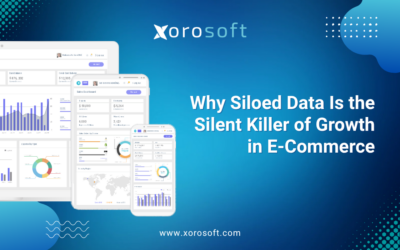
Why Fast-Growing Brands Need a Centralized Operations Dashboard
As multi-channel brands expand, the need for a clear and reliable view of operations becomes impossible to ignore. Because growth adds complexity quickly, many leaders discover they need a centralized operations dashboard to regain clarity, streamline communication, and eliminate manual reporting. Although the early stages feel manageable, the lack of one unified view eventually slows decision-making and creates unnecessary stress.
Founders and operations leaders often share the same desire: they want more time to focus on growth rather than searching for scattered information. Since a centralized operations dashboard brings all essential data into one place, it becomes much easier to guide the business with confidence. Moreover, having a single window into orders, inventory, and fulfillment allows teams to stay aligned as the business evolves.
A centralized operations dashboard does not remove complexity. Instead, it organizes it logically. Consequently, leaders gain the mental space to think clearly and act proactively rather than firefight throughout the week.
How a Centralized Operations Dashboard Reduces Hidden Frictions
Even well-organized operations teams face silent frictions that drain time and energy. Although many of these tensions feel small individually, they accumulate until they slow the entire organization. Because data often lives across multiple tools, teams spend hours assembling reports manually.
These frictions appear in common ways:
-
Data spread across Shopify, Amazon, retail platforms, 3PL portals, and spreadsheets
-
Inventory numbers updating slowly or inconsistently across channels
-
Conflicting truths between departments when reporting inventory, orders, or performance
-
Slack conversations dominated by status checks and missing details
-
Operational blind spots that surface only after customers complain
Since these issues deepen as channels grow, brands eventually feel overwhelmed. However, a centralized operations dashboard reduces these frictions by showing every critical metric in one accurate, real-time view.
To see examples of how software reduces operational friction, you can Explore XoroONE Furthermore, leading comparisons like G2’s ERP rankings highlight how consolidated systems improve accuracy for multi-channel brands.
Operational Metrics That Improve After Using a Centralized Operations Dashboard
Once brands implement a centralized operations dashboard, certain metrics improve earlier than others. These are often the metrics that influence customer experience and profitability most directly. Because the dashboard creates consistency, teams stop guessing and start reacting based on real data.
The areas that usually improve first include:
-
Pick accuracy, which reduces mis-ships and customer frustration
-
Order cycle times, allowing faster movement from purchase to fulfillment
-
Cash conversion cycle, since purchasing becomes more responsive and accurate
-
Channel profitability, offering visibility into margin erosion
-
Inventory turnover, reducing capital tied up in slow-moving stock
Although every brand starts from a different point, dashboards stabilize operations by providing teams with the same information simultaneously.
For a deeper look at performance improvements, you can review examples on our Case Studies page.
How One Brand Improved Operations Through Clear Dashboard Visibility
A mid-size apparel brand selling across direct-to-consumer, wholesale, and Amazon faced growing operational challenges as order volume increased. Because the operations manager spent more than a dozen hours each week compiling reports, the team constantly operated with incomplete information. Moreover, inventory numbers across channels rarely matched, which often caused overselling during promotions. Customer complaints related to delays and shipping issues became increasingly frequent.
After implementing a centralized operations dashboard, the team saw changes almost immediately. Since inventory synced across channels in near real-time, confusion around stock levels disappeared quickly. Morning standups shifted from long problem-solving sessions to brief five-minute reviews. Additionally, forecasting decisions improved because the team relied on updated information rather than outdated spreadsheets.
Within the first 90 days, several metrics changed significantly:
-
Pick accuracy increased from 92% to 98.5%
-
Order cycle time fell from 2.1 days to 1.4 days
-
Customer complaints declined from 5–8 per week to 1–2 per week
-
Cash conversion improved by 11 days, freeing critical capital
Although the technology created the foundation, the real shift came from visibility. Since the team could see issues earlier, they addressed problems before they escalated.
Why a Centralized Operations Dashboard Creates True Alignment
A centralized operations dashboard succeeds because it unifies the systems that teams rely on daily. While many companies believe they need to overhaul their entire stack, they often just need one reliable data connection. Because dashboards integrate with commerce channels, 3PLs, accounting platforms, and warehouse systems, they form a single source of truth without requiring complex implementations.
Furthermore, starting with inventory and order data produces an immediate improvement. Once those areas stabilize, leaders can add forecasting, purchasing, and profitability layers to the dashboard. Since the dashboard functions as a hub, each new integration enhances clarity rather than creating additional complexity.
Defining consistent terminology across teams becomes possible as well. When everyone understands what “available inventory” or “aging stock” means, decision-making improves dramatically. Consequently, teams spend less time debating numbers and more time solving actual problems.
For additional insights into operational clarity, Shopify’s research on fulfillment efficiency also highlights the importance of real-time visibility. You can reference their marketplace insights here: Shopify App Marketplace – Xorosoft.
Steps That Help Brands Build Dashboard-Driven Operations
Although the idea of implementing a centralized operations dashboard may seem daunting, breaking the process into clear phases helps teams move forward confidently. Because each step builds on the last, brands can make progress without disrupting daily operations.
Clarify the Most Important Operational Question
The first step involves identifying the main question that determines operational success. For many multi-channel brands, this question is simple: “Are we fulfilling on time across every channel?” Although straightforward, this question helps determine which data should appear on the dashboard first.
Map Your Core Data Sources
Next, list the systems that your team depends on each week. Because many brands rely on six or more platforms—such as Shopify, Amazon, wholesale tools, 3PL systems, and spreadsheets—mapping these sources helps identify integration priorities.
Connect Inventory and Order Data Early
Inventory and orders change most rapidly, so connecting them first creates immediate clarity. When the dashboard displays near real-time updates, the rest of the operation begins to stabilize naturally.
Standardize Key Operational Definitions
Many operational disagreements arise from inconsistent definitions. Therefore, documenting what terms like committed stock, returns, or in-transit items mean across teams reduces avoidable confusion.
Set Up Alerts for Exceptions
Dashboards excel at detecting unusual behavior. Since alerts can highlight low stock, stuck orders, mismatched counts, or aging inventory, they help teams catch problems long before customers notice.
Establish Daily and Weekly Dashboard Habits
Visibility becomes far more effective when tied to routine. A short daily scan and a weekly review allow teams to keep a pulse on performance. Because the dashboard consolidates everything, these reviews require far less time than traditional status checks.
Connect Visibility to Profitability
Ultimately, dashboards support profitability. Since teams make fewer mistakes and rescue issues earlier, operational costs decline. As a result, brands free resources to invest in new channels, product development, or growth initiatives.
A Practical Weeklong Rollout for Multi-Channel Teams
Although each brand operates differently, a simple weeklong plan helps teams adopt a centralized operations dashboard without feeling overwhelmed.
- Day 1: Identify recurring operational breakdowns and gather examples of where data is inconsistent.
- Day 2: Map the entire tool ecosystem to understand data flow.
- Day 3: Select a dashboard platform that connects to your existing stack and supports multi-channel visibility.
- Day 4: Integrate your sales and fulfillment channels to create a unified starting point.
- Day 5: Build a core view of inventory, orders, and in-transit goods.
- Day 6: Configure alerts for low stock, delays, and discrepancies.
- Day 7: Review the new system with your team and capture quick improvements.
Because this flow balances setup and quick wins, it encourages adoption across departments.
Important Questions Brands Often Ask During Dashboard Adoption
As teams move toward centralized visibility, a few common questions consistently emerge. These questions help determine whether the dashboard will align with long-term operational goals.
Many leaders ask whether technical experience is required. Thankfully, modern dashboards are designed for operators rather than developers. If someone can connect a Shopify app, they can set up a dashboard.
Some worry that a dashboard may replace their existing systems. In reality, dashboards unify those systems rather than replace them. They serve as a bridge that makes everything easier to understand.
Teams also wonder whether dashboards help with forecasting. Although dashboards are not forecasting engines, they provide cleaner data, which significantly improves forecasting accuracy.
Lastly, leaders want to know how long it takes to see results. Most brands experience meaningful improvements within 30–60 days, especially regarding accuracy and cycle times.
For a personalized walkthrough, book a live demo today that provides detailed guidance.
Building a More Predictable and Confident Operation
When multi-channel teams gain immediate visibility into what is happening across the business, operations become calmer and more predictable. Because a centralized operations dashboard gives leaders accurate data in one place, they can make faster and more confident decisions. As a result, teams spend less time reacting and more time building the future of the brand.
If you want to compare leading options, you can review platforms ranked by ease of use on G2 or explore the Shopify app ecosystem for solutions like Xorosoft’s dashboard integrations. Although tools matter, clarity matters more—and clarity begins as soon as all your data finally comes together.









